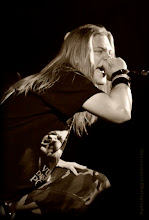Here are some examples of typical Cartoon expressions:
Here we have Dexter from the Cartoon Network series "Dexters lab". Notice how his body is all directionally aligned to the same posture, and his eyebrows frowning, teeth grited to give the expression of seething anger.
Here you can see a scene from Family Guy, where Stewie is caught shaving by Brian the Dog. Look at how Stewie's head is turned around, yet facing the opposite way to Brian. This shows how he is embarassed to look directly at Brian, also this is a way to show Stewies facial expression in more detail. Brian is covering his face in shock, yet still able to peer over his hand creating an interaction between the two characters eye contact.
Here you can see the Characters Buzz and Woody from Toy story. Here we have two CG Characters, however, their cartoonish style and over exagerated features help to keep the characters movements away from the uncanny and retained in the world of cartoon humour.
Here is a film which uses elements of CG and contains real life actors, however retains the elements that build up that of a typical cartoon for the characters actions. In this film, which is marketed mainly towards kids, really invokes a slight uncanny experience to the viewer. The cartoon stylization behind the real life characters becomes somewhat strange, and doesnt feel quite right. This kind of approach to image has been used in other childrens films and media, for example the recent tv series "Lazytown".
Chris





No comments:
Post a Comment